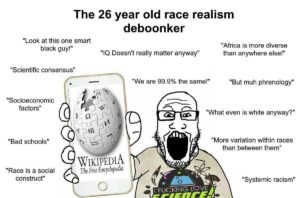There seems to be some disagreement about what the term human biodiversity covers. I’ll be reaching out to the prototypical HBD people to ask what they think. However, my own understanding is a broad one and seems to be near-identical to that HBDChick expressed in the following posts:
- – https://hbdchick.wordpress.
com/2014/08/21/what-is-human- biodiversity-hbd/ - – https://hbdchick.wordpress.
com/2014/08/21/examples-of- human-biodiversity-hbd/ - – https://hbdchick.wordpress.
com/2014/08/21/what-human- biodiversity-hbd-is-not/
Namely:
human biodiversity (hbd) is very simply the diversity found among and between human populations that has a biological basis.
I think she means genetic, not biological basis. Any differences caused by environmental means — e.g. lead content in environment — are ultimately expressed via the biology of the brain. The same point was recently made by Haier in his book on neuroscience. But it seems to be a common problem that people conflate genetic and biological. It seems like this is an effect of (implicit) Cartesian dualist thinking, where the mind i explicitly non-biological.
Following HBDChick’s definition, in my view, HBD includes any genetic differences between individuals and groups of individuals such as:
- The sexes.
- Obese and thin people.
- Tall and short people.
- Smart and dull people.
- Red- and light haired-people.
- Blue and green-eyed people.
- Those with wet or dry earwax.
- Political groups: conservatives, libertarians, greens, socialists, communists, anarchists, Nazis and everything in between.
- Within nation cultural differences such as American nations, the North-South divide in Italy, and the rural vs. the urban.
- Music or lifestyle-related groups such as goths, metal heads, hippies, trance-lovers, polyamorians, classical music lovers, and those who are into BDSM.
- Occupation and social status related differences: farmers, working class, upper class, lower class, middle class, policemen, academics, media people, craftsmen, business people and so on.
- Nationality groups between Danes and Spaniards.
- Differences between today’s humans and recently extinct group such as Denisovans and Neanderthals.
- Differences between any larger collection of groups, such as Pygmies, Bantu peoples, Ibos, Nordics, Turks, Siberians, Japanese, Chinese, Thai, Polynesians, Australoid, Arabs, Amerindians, and any number of other groups.
- Any differences between individuals with a genetic basis, including between family members such as siblings.
HBDChick herself mentions as examples:
- Hair color.
- Eye color.
- Skin color.
- EDAR (a genetic related to embryonic development).
- Sickle-cell trait.
- Lactase persistence.
- High-altitude adaptions.
- Cold adaptations.
- Height in pygmies.
- ASPM (gene related to brain development).
- MCPH1 (gene related to brain development).
- Microbiomes.
In terms of academic fields, HBD encompasses topics studied in:
- Evolutionary psychology/sociobiology.
- Differential psychology.
- Behavioral genetics.
- Medical genetics.
- Population genetics.
- Human genetics in general.
- Any inter-disciplinary areas that take genetics into account such as using bordering with economics, linguistics, criminology, sociology and political science.
In my view, then, HBD is both a natural fact that humans differ in various ways due to genetic causes, and also a meta-field of science encompassing the above.
Per the above, some grey ares are, in my opinion:
- Microbiomes. Some of these will be due to the genetics of the host as well as complex inter-organism genetic interactions. Others will be due to local environment.
- Transgenerational epigenetics. All the others above are DNA-related and of course DNA also alter gene expression. However, it’s likely that the environment does this too, and possibly in ways that can be inherited (to speak loosely).
